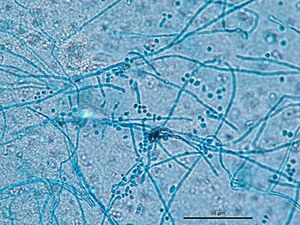Trichophyton mentagrophytes
Classification
Fungi; Ascomycota; Eurotiomycetes; Onygenales; Anthrodermataceae
Species
T. mentagrophytes
Description and Significance
Trichophyton Mentagrophyte comes from the name "mentagre" which means "plants caught under the chin" in Greek and Latin etymology. It is also be known as Ringworm or Dermatophytes [3].
Zoophilic fungus with distribution worldwide with a wide range of animal hosts. Rarely causes clinical disease. Dermatophytes are the leading cause of superficial fungal infections in keratinized tissues, affecting 20–25% of the global population. Trichophyton Mentagrophyte produces inflammatory skin or scalp lesions, a kerion(inflammatory, pus-filled sore) may occur in the beard or scalp as well. Colonies are a white creamy color, flat, with a powdery to granular surface. Reverse pigmentation shows up as a yellow-brown or reddish-brown color [2].
Genome Structure
Flat, white creamed colored, gram positive. It produces small, spherical or clavate microconidia in grape-like structures. They also produce rare 2-5 cell macroconidia. Cultures of Trichophyton mentagrophytes form dense clusters of microconidia and varying in numbers of spherical chlamydospores, and spiral hyphae [2]. Some cultures show central folding or develop raised central tufts or pleomorphic suede-like down areas [7].
Cell Structure, Metabolism and Life Cycle
Microconidia of T. mentagrophytes are hyaline, smooth-walled, spherical to subspherical in shape, and occasional pyriform to clavate or of irregular shape. They are clavate to fusiform, and thin- or thick-walled with 4-5 cells separated by parallel cross-walls, which are laterally directly grown on the hyphae or on short pedicels. During morpho-physiological reduction and differentiation, T. mentagrophytes can assimilate phosphorus, potassium, sodium, and calcium and utilized glucose and amine nitrogen. Different from other dermatophytes, plenty of mitochondria and granules are observed in T. mentagrophytes. It has a preference for methionine as nitrogen sources and can’t utilize the trisaccharide melezitose probably due to lack of specific enzymes [5].
It has been shown that progesterone inhibits the growth of Trichophyton mentagrophytes and escapes from this inhibition over time. Escape from inhibition is related to the enzymatic transformation of progesterone to polar metabolites. Progesterone metabolites confirm the production of 15a-hydroxyprogesterone. Two of these were determined to be 1-dehydroprogesterone and 11α-hydroxyprogesterone. The third metabolite was a 1-dehydro-hydroxyprogesterone. These three derivative are significantly less inhibitory to the growth of T. mentagrophytes than progesterone [4].
Ecology and Pathogenesis
Trichophyton mentagrophytes is contracted by touching someone with the virus, even an animal. Symptoms include skin lesions, sparse hair, and chalky surface on the skin. The lesions are composed of debris, exudate, mycelia and arthrospores with underlying dermatitis [3]. T. mentagrophytes is complex in that it is composed of 5 other variants that are zoophilic dermatophytes. T. mentagrophytes can assimilate sodium, calcium, phosphorous potassium, and glucose during morpho- physiological reduction. Many granules and mitochondria are observed in T. mentagropytes compared to other dermatophytes. Keratinolytic enzymes have been isolated from many strains of T. mentagropyhtes which plays a role in pathogenesis of infection in humans and animals [7].
References
[1]Ma, Y., Deng, W., Zhang, K., Song, Y., Zhang, L., Shao, J., Liu, X., Wan, Z., Wang, X., & Li, R. (2022, September 20). Dual RNA-sequencing and LC–ms unveil specific insights on the pathogenicity of Trichophyton mentagrophytes complex. Journal of Investigative Dermatology. Retrieved November 18, 2022
[2]Ellis, D. (2016). Trichophyton. Mycology | University of Adelaide. from https://www.adelaide.edu.au/mycology/fungal-descriptions-and-antifungal-susceptibility/dermatophytes/trichophyton#trichophyton-mentagrophytes
[3]Bennett, J., Whary, M., & Barthold, S. (2015). Trichophyton mentagrophytes. Trichophyton Mentagrophytes - an overview | ScienceDirect Topics. https://www.sciencedirect.com/topics/biochemistry-genetics-and-molecular-biology/trichophyton-mentagrophytes
[4]Clemons, K. V., Stover, E. P., Schär, G., Stathis, P. A., Chan, K., Tökès, L., Stevens, D. A., & Feldman, D. (1989, July 5). Steroid metabolism as a mechanism of escape from progesterone-mediated growth inhibition in Trichophyton mentagrophytes. Journal of Biological Chemistry. Retrieved from https://www.jbc.org/article/S0021-9258(18)60447-8/fulltext
[5]Trichophyton mentagrophytes. Trichophyton Mentagrophytes - Creative Biolabs. (n.d.). Retrieved November 18, 2022, from https://www.creative-biolabs.com/drug-discovery/therapeutics/trichophyton-mentagrophytes.htm#:~:text=mentagrophytes%20are%20hyaline%2C%20smooth%2Dwalled,hyphae%20or%20on%20short%20pedicels
[6]Alshahni MM, Yamada T, Yo A, Murayama SY, Kuroda M, Hoshino Y, Ishikawa J, Watanabe S, Makimura K Insight into the draft whole-genome sequence of the dermatophyte Arthroderma vanbreuseghemii. Sci Rep. 2018 Oct 11;8(1):15127. doi: 10.1038/s41598-018-33505-9
[7]Trichophyton mentagrophytes. Trichophyton Mentagrophytes - Creative Biolabs. (2022). Retrieved December 12, 2022, from https://www.creative-biolabs.com/drug-discovery/therapeutics/trichophyton-mentagrophytes.htm
Author
Page authored by _Caroline Doby__, student of Prof. Bradley Tolar at UNC Wilmington.

